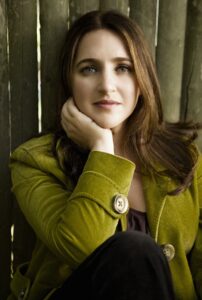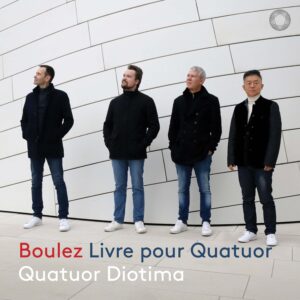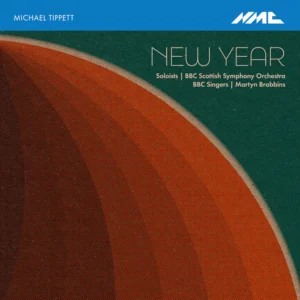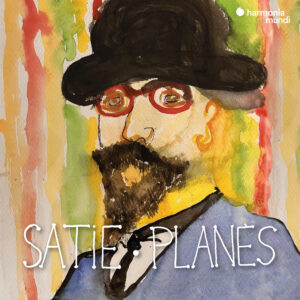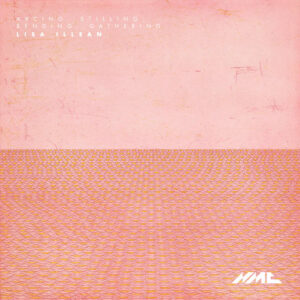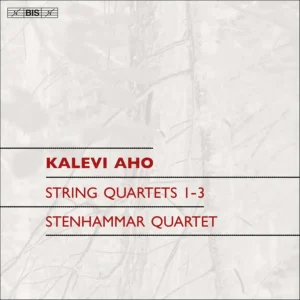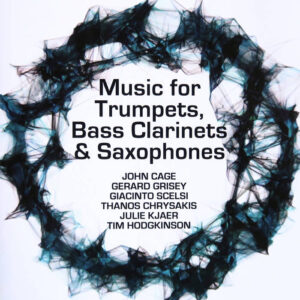
Unseen World is a new release by composer Mara Gibson on the Mark Masters record label. The album consists of five works composed between 2020 and 2024 that are inspired by vivid visual art that is both expressive and complex. Various instrumental ensembles are employed including a piano and cello duet, a brass quintet, trumpet duet, woodwind duet and a large chamber orchestra. The meticulous writing present in the scores, the outstanding technique of the musicians and remarkable efforts by the soloists make Unseen World an impressive realization of contemporary musical expression.
The first piece on the album is Swansongs (2022). This is a three movement work that features Albina Khaliapova at the piano and Eduard Teregulov on cello. The piece is inspired by Swedish artist Hilma af Klint (1862-1944), and was commissioned by the performers.
“Hilma’s Symmetry (and Chaos)”, the first movement, opens with a deliberate series of strong and dissonant piano chords that rise successively in pitch. This soon changes to a rapid, running line in the piano accompanied by long sustained tones in the cello underneath. A sense of anxiety builds as the lines weave in and around each other. The cello adds to the tension with sharp pizzicato phrases and bright arco passages. About two thirds through, there is a sudden slowdown, with a mournful cello solo accompanied by single notes from deep in the piano. The movement ends with a solitary low note in the lowest piano register. The piece is just three and a half minutes long and the liner notes suggest that this movement is reminiscent of the “…expressionistic paintings of the beginning of the 20th century.” A very apt description.
“Hildegard”, the second movement, opens with a low growl in the cello followed by a quickly running stream of piano notes in the upper registers. Right from the beginning there is a sense of heightened tension. The cello soon joins in with faster gestures and the lines again weave in and around each other, alternating between conflict and cohesion. The low tones from the cello contrast nicely with the higher moving notes in the piano. About midway, the piano and cello are heard in the same middle/low register and this replaces the tension with a feeling of chaos and confusion. The tempo slows from its frenetic pace, and quietly subdued notes are heard from the piano at the finish. The fast tempo, changing dynamics and complex texture of this movement highlight the seasoned technique that the two musicians have brought to this piece.
The final movement, “Lock and Key”, begins in a completely different direction with soft piano notes. A mournful, sustained tone is heard high in the cello, bringing a painful feel to this. The cello continues in its slow, expressive line with the piano grimly accompanying underneath. The two performers of this piece write in the liner notes: “Hypnotizing harmonies of the movement force the listeners and performers to detach from the fast-paced reality and focus on their inner world.” “Lock and Key” is a satisfying contrast to the first two movements and provides a fittingly solemn ending to Swansongs.
Next is Fight|Flight, (2020), written in close collaboration with the Atlantic Brass Quintet, who premiered the piece in 2022. The piece was inspired by both the human responses to danger and the making of honey by bees. A strong buzzing sound is heard at the opening, produced by the brass players using only their mouthpieces. This establishes the unmistakable context of frenetic flight. Warm brassy tones are soon heard, as if we are in the presence of a large swarm of bees. A sharp and loud trumpet call enters, announcing the more militant ‘fight’ motif. Soon all the brass players are exchanging sharp phrases back and forth, as if sparring. The various horn lines soon dissemble into a general melee. The technique and dynamic interplay in this section is impressive and the result sounds like more than just five players. The congenial mouthpiece buzzing returns in the last minute of the piece, as it slowly fades to its finish. Flight Fight is an inventive combination of the diverse sounds that can be conjured from a single brass quintet.
Pranayama (2021), is a woodwind duet performed by Melody Wan, flute and Thomas Kim on clarinet. The inspiration for this piece comes from yoga breathing practice and the painting “Ringing Lung”, by Anne Austin Pearce. Low, slow clarinet tones open the piece suggesting intentional patterns of breathing. The flute joins in and the flowing tones weave their way through various registers and colors. There is a meditative feel to this with just the slightest tinge of sadness. A rapid trill in the flute, then followed by the clarinet, add some energy and optimism along with loud and quick runs up and down a series of scales. The dynamics rise and fall suggesting the movement of air in breathing. As the piece proceeds, the occasional dissonance and pitch bending add intensity to the textures, matching the fluidity of the visual art. The piece ends as quietly as it started. With its many moods and nuances, Pranayama rests squarely on the virtuosity of the performers, and they do not disappoint.
Snowball (2024), was inspired by a Susan B. Anthony quote: “The older I get, the greater power I seem to have to have the world. I am like a snowball – the further I am rolled, the more I gain.” This piece is for two trumpets, performed by Jena and Matthew Vangjel who recorded this piece just a week before the birth of their second child.
Snowball opens with a muted solo trumpet repeating a line of solid, declarative notes. The second trumpet enters, similarly muted and in the same register with a lovely harmonic interleaving of the two parts. The mute on one trumpet is then changed and this provides a striking contrast in timbre. As the piece proceeds, the mutes are alternately changed – or removed – producing an ever-changing series of surfaces and colors. The tempo and rhythms are steady and direct, but with a just enough complexity to engage the ear. Towards the finish, the dynamic levels increase, bringing out the familiar forward boldness inherent in two solo trumpets. Snowball artfully reveals many surprising sonic possibilities, all lurking in the conventional trumpet.
Escher Keys (2021) is the most ambitious work of the album, a full blown bassoon concerto in three movements with a duration of 26 minutes. The soloist is Darrel Hale and the 39 piece chamber orchestra is conducted by Scott Terrell. Lithographs and a woodcut by the artist MC Escher provided Gibson with the visual inspiration for this piece and the result is a rich mixture of intense abstraction and powerful expression. As the liner notes explain: “Each movement juxtaposes traditional and non-traditional instrumental relationships between Hale interjecting his statements and the orchestra responding with atmospheric tessellations…”
“Ascending and Descending”, the first movement, opens with solemn, sustained tones in the strings with a quiet drum beat underneath. The bassoon enters in the same fashion and immediately rises to the top of the texture. Woodwinds and the brass join in with bold notes of dissonance accompanied by tense rhythms in the strings and anxious tones from the bassoon. Rapid runs by the soloist and short repeating phrases in the orchestra add to the tension. About midway, the tempo slows and the sustained tones briefly return with the bassoon leading the way. An ascending run of pitches in the winds and brass add energy, followed by a lonely bassoon solo that brings an isolated and melancholy feel. The bassoon playing is very expressive here and the solo continues with slowly descending notes to quiet conclusion. A final deep tone is heard in the string bass at the finish.
Movement two is “Three Worlds” and this begins with solitary and tentative growls from the bassoon, slow and sustained at first, but escalating into bouncy and rapid rhythms. Now the bassoon is heard in a higher register, accompanied by the strings and an oboe trading short, snappy phrases. More woodwinds join in and the various lines alternately separate, then join in tutti chords. There is a wonderful mix of cascading and descending pitches always on the move, playfully chasing and swirling around each other. Towards the finish, a solemn bassoon solo produces a more introspective feeling and the piece ends quietly on a low tone. “Three Worlds” exhibits excellent musicianship and coordination between the soloist, especially given the many complex responses summoned from the orchestra.
The concluding movement for Escher Keys is “Day and Night” and “Waterfall”. There is a subtle, rural feel to this, as the liner notes explain: “Beginning in the sky of the first image, the listener moves back and forth, side to side.” The movement opens with high, sustained flute tones that establish an air of mystery. The solo bassoon enters with a moving line – at first with a curious feel, then with bolder declamatory passages. The rapid notes could suggest the activity of birds in a field. Long, flowing orchestral passages are soon heard underneath, suggesting a pastoral river scene. This becomes progressively more complex as the various orchestral sections follow with independent lines that weave in and around the soloist.
After a brief silence there are low, growling tones by the solo bassoon that suggest a bit of sadness and frustration. Warm string tones enter as the bassoon and a solo violin exchange phrases, building tension. A breathy sound is heard from the bassoon, followed by a more conventional, solitary notes. Concerto for Orchestra springs to mind; “Day and Night” delivers a level of atmospheric mystery similar to the Bartok classic.
Strings enter with ascending figures comprised of blurred pitches. Loud percussion and the bassoon are heard in the foreground – more anxious now. The concerto concludes with a long sustained tone in the bassoon and a high, questioning violin note. Escher Keys is abstract music inspired by abstract art. The vivid expression heard in the ear matches the intensity of the optical experience of the eye. The fidelity of the music to the visual is result of Mara Gibson’s masterful score, the precise playing in the orchestra and the virtuosity of soloist Darrel Hale.
Unseen World is available as a digital download or physical CD from Mark Custom.

